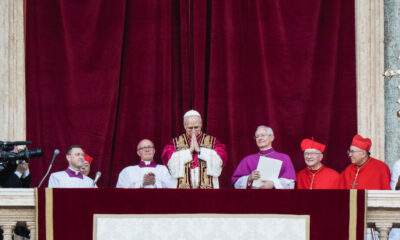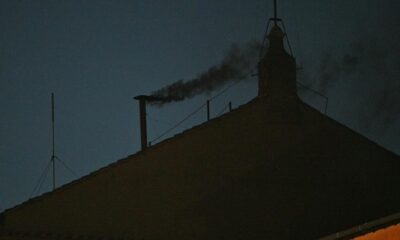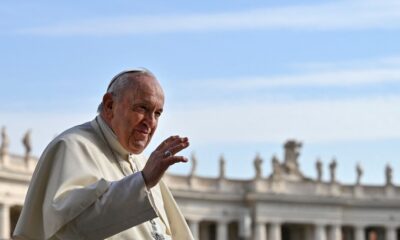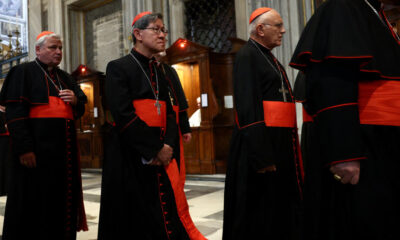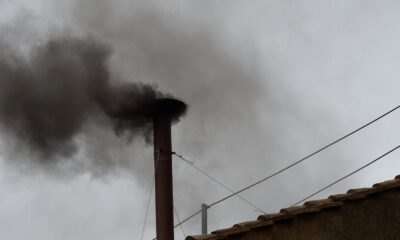Breaking News
Francis Is in Critical Condition. What Happens When a Pope Dies?
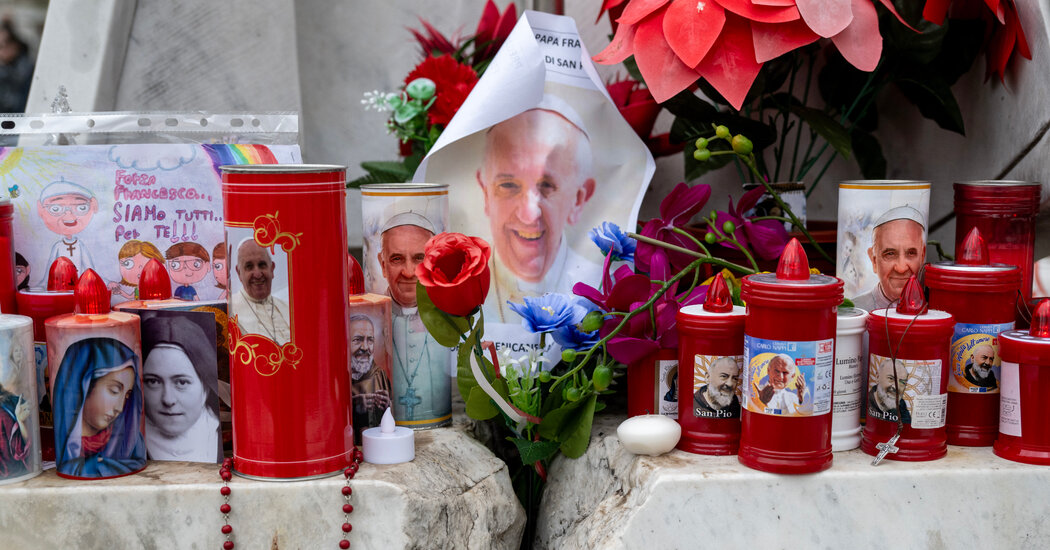
The Catholic world is filled with uncertainty as Pope Francis, 88, remains in critical condition in a Rome hospital due to a complex lung infection and other serious ailments.
The Vatican announced on Tuesday morning that Francis had a restful night, following a day of slight improvement in response to therapy.
Cardinals gathered in front of St. Peter’s on Monday evening to lead a rosary for the pope.
Here is what is known about his condition and the procedures that would be followed should he pass away.
Francis’ Health
Francis’ initial respiratory infection has progressed to pneumonia in both lungs, with additional complications arising during his hospitalization.
He experienced a respiratory crisis that necessitated high levels of oxygen. The Vatican disclosed on Sunday that he was dealing with “mild kidney failure,” which was being managed.
Various medications are being used in his treatment, with doctors facing challenges in finding the right balance. Given his age and lung issues, his prognosis is being approached cautiously.
After Death Procedures
While the outcome for Francis is still uncertain, the established rituals for ensuring secrecy and a smooth transition have been refined over centuries. The meticulously planned ceremonies bring order to a church experiencing a significant period of change.
Confirmation of a pope’s passing is promptly made by the head of the Vatican’s health department and the cardinal chamberlain of the Holy Roman Church, who assumes the role of the Vatican’s de facto administrator. The pope’s body is dressed in a white cassock and taken to his private chapel.
The cardinal chamberlain, currently Cardinal Kevin Joseph Farrell, a 77-year-old American of Irish descent, is responsible for this role. Along with other officials and the pope’s family members, a ceremony takes place in the chapel. The pope is placed in a wooden coffin lined with zinc, dressed in red with his miter and pallium placed nearby.
Following the ceremony, the chamberlain prepares a document certifying the pope’s passing, with the doctor’s report attached. The pontiff’s personal papers are secured, and his living quarters, in the case of Francis, a significant portion of the second floor at Casa Santa Marta, the Vatican City guesthouse utilized by visiting cardinals during his papacy, are sealed.
Furthermore, arrangements are made for the ceremonial destruction of the pope’s “fisherman’s ring,” used for sealing documents, to prevent any potential forgeries.
Paying Respects
Francis has introduced a modest approach to the church, eschewing elaborate attire and opulent papal residences. This emphasis on humility extends to his funeral arrangements, which have been streamlined to reduce some of the traditional pomp and ceremony.
In a revision of funeral rites in 2024, Francis simplified certain aspects. Since the 13th century, deceased popes have been displayed publicly, their embalmed bodies placed on an elevated platform. However, instead of the private viewing for cardinals, bishops, and dignitaries that occurred following John Paul II’s passing in 2005, Francis opted for a public viewing in St. Peter’s Basilica without the raised pedestal. “Francis chose to emphasize humility over glorification,” noted church historian Agostino Paravicini Bagliani.
The College of Cardinals determines the schedule for transporting the pope’s body to St. Peter’s Basilica, led by the chamberlain, and the commencement of the public viewing.
Funeral Arrangements
The pope’s funeral and burial must occur within four to six days of his passing, with funeral rites in various Roman churches lasting nine days.
Traditionally, deceased popes were placed in three nested coffins made of cypress, zinc, and elm. However, in a departure from tradition, Francis decreed that he would be interred in a single wooden coffin lined with zinc.
The coffin is sealed the night before the funeral, with the pope’s face covered by a white silk veil. He is buried with a pouch containing coins minted during his papacy and a container with a brief record, known as a “rogito,” outlining details of his life and papacy. The “rogito” is read aloud before the coffin is closed.
Additionally, the revised guidelines permit a pope to be buried in a church other than St. Peter’s Basilica. Francis expressed a desire to be laid to rest in the Basilica of St. Mary Major, a church of personal significance where he frequently prayed before an icon of the Virgin Mary.
The Conclave
Within 15 to 20 days of the pope’s passing, the dean of the College of Cardinals, Cardinal Giovanni Battista Re, 91, will convene the cardinals in Rome for a conclave to elect Francis’ successor.
The period between a pope’s death and the election of a new pontiff, known as the sede vacante or “the seat is vacant,” sees the College of Cardinals overseeing the church without making major decisions.
During the conclave, cardinals are confined to Casa Santa Marta, a residence established by John Paul II to replace the previous makeshift accommodations in the papal palace.
Cardinals are generally prohibited from leaving the conclave, with the term “conclave” referring to the isolation imposed to expedite the electoral process.
Throughout the conclave, smoke is released through a chimney visible from St. Peter’s Square after each round of voting. Crowds gather to observe the color of the smoke, with black indicating no decision reached and white signifying a new pope has been elected.
Upon selection, the chosen successor is asked by the dean of the college if he accepts the role. Following an affirmative response, the new pope is clothed in a white cassock in the chapel’s sacristy. He then proceeds to a balcony of St. Peter’s Basilica, where a senior cardinal announces in Latin, “Habemus papam” or “We have a pope.”
-

 Destination8 months ago
Destination8 months agoSingapore Airlines CEO set to join board of Air India, BA News, BA
-
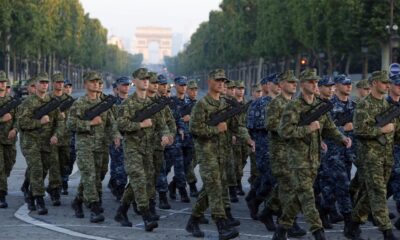
 Breaking News10 months ago
Breaking News10 months agoCroatia to reintroduce compulsory military draft as regional tensions soar
-

 Tech News12 months ago
Tech News12 months agoBangladeshi police agents accused of selling citizens’ personal information on Telegram
-

 Gadgets3 months ago
Gadgets3 months agoSupernatural Season 16 Revival News, Cast, Plot and Release Date
-

 Productivity11 months ago
Productivity11 months agoHow Your Contact Center Can Become A Customer Engagement Center
-

 Gadgets3 weeks ago
Gadgets3 weeks agoFallout Season 2 Potential Release Date, Cast, Plot and News
-

 Breaking News10 months ago
Breaking News10 months agoBangladesh crisis: Refaat Ahmed sworn in as Bangladesh’s new chief justice
-

 Toys12 months ago
Toys12 months ago15 of the Best Trike & Tricycles Mums Recommend

